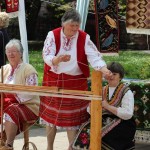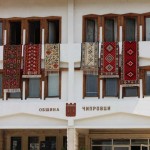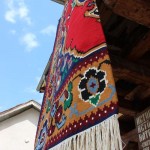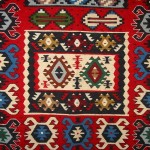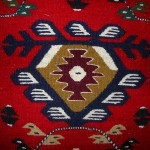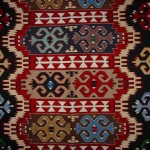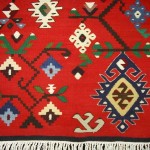The magic carpets from Chiprovtsi
The Major of Bulgarian town Chprovtsi Plamen Petkov received an official Certificate for “The tradition of carpet-weaving” from the UNESCO Director-General Irina Bokova personally. The document was given during the official opening of the two-day international forum themed “The contribution of UNESCO Member States of South-Eastern Europe to the dissemination and implementation of the UNESCO Convention for the Safeguarding of the Intangible Cultural Heritage 2003”.
Plamen Petkov presented Irina Bokova with a traditional carpet from Chiprovtsi, made by Sevka Bardinska with original patterns “kanatitsa”, “birds” and “makasi”. It is believed these patterns are keeping the evil away and foreseeing health and prosperity.
The tradition of carpet-weaving in Chprovtsi is included in the UNESCO intangible cultural heritage list in 2014. The rugs are unique by their technique of making and two absolutely identical sides. The local carpets have been prized at exhibitions in London, Paris, Liège and Brussels.
Local rug-weaving tradition
The earliest information about rug-weaving in Chiprovtsi date back to the beginning of the 17th century. In 1896, almost 1,400 women from the town and the region were engaged in carpet-weaving. The carpets made in this period were marked by smooth dense texture, geometric patterns and harmonious combinations of warm and cool natural tints: yellow or ochre, brown, blue and green. They were called bakkam at first after the bakkam tree (Caesalpinia Sappan) or “Garibalda” (an item of clothing). The triangle is the main pattern of those carpets. The Karakachanka figure (‘the black-eyed bride’) is also typical in that period. These two types and all other kinds of the Chiprovtsi rugs as well have no analogue in the world.
The next period in the development of carpet-weaving, also known like the decorative period, continued throughout the 19th century to the Bulgarian Liberation in 1879, when was the flourishing state of the craft. All decorative elements were inspired from the nature – trees, shrubs, stars, birds, animals and flowers.
The ornamental period of the Chiprovtsi carpets began from the Liberation and continues to the present day. The new trends of lifestyle and the competition of imported rugs have encouraged the use of larger palette and ornamental patterns.
The symbolism in the carpets’ ornaments is ancient and most likely originated from the magical and religious symbols of proto-Bulgarians. The triangle is main figure. When apex is upward symbolized the male beginning, the opposite means woman’s.
The rhombs’ varieties create “kolata” (the waggon) – symbol of the infinity, the eternity, the changeability in the things on Earth. It shows also the will and human sexuality.
Two triangles turned apex to apex form “makasi” (scissors) – symbol of the time, also represent big, free man like one of the letters in the ancient Bulgarian alphabet.
Today still persists the belief that Chiprovtsi carpets are not just an interior decoration at home, but also ensure the place and its inhabitants protection and luck.



